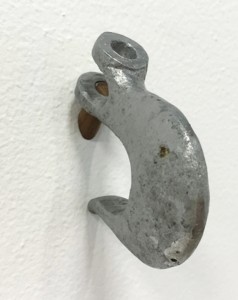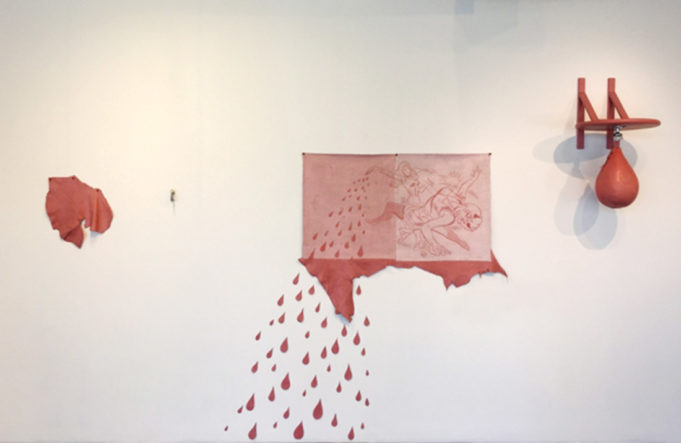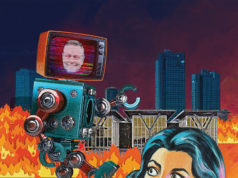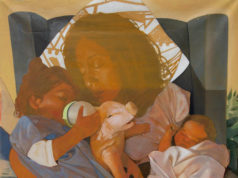Fort Worth Contemporary Arts is one of only a few galleries in the city bringing an international taste of art happening right now to town. Run by TCU, FWCA also serves as an introductory gallery for artists coming out of the school’s Master of Fine Arts program.
Hanging there now is the last Transmission, an annual exhibit that started five years ago but that will end when all of the pieces come down next week –– the MFA program around which the yearly show revolves has been expanded to three years from two, and Transmission will now serve as a review.
This Transmission represents a wide range of media, from paintings to drawings, sculpture to installation, and although not everything moves beyond testing out ideas, some seem just about there.
The most striking piece is Barbara Horlander’s “She Devil’s Comeuppance.” It’s a monochromatic painting of a woman in fishnet stockings being slapped backward by another woman. Very pulp fiction, with a hint of Roy Lichtenstein-ian pop. But it’s also a feminist nod to Judy Chicago and photographer Nan Golden, female artists from another generation, revealing an emerging artist willingness to embrace not only the demure but also the downright hardscrabble attributes of her subject. Horlander describes her painting as an examination of universal concerns, such as anxiety, insecurity, and self-loathing. In this scene in particular, she explores these feelings “in the context of female competition, as related to personal achievement and physical beauty.”
“Comeuppance” is sandwiched between two other Horlander pieces. “Training Device #1” (a speed bag with embroidered womanly lips) and “So They Say” share the same materials and theme. They’re all pink, but all connotations of softness have been removed.

Regrettably, they are interrupted by the phallic insistence of “#1” from Facsimiles: 1-7 by Mason Bryant. This sequence of 3-1/4-inch aluminum hooks anchored by walnut studs is an otherwise strong conceptual, if minimal, offering. Their positioning at seemingly random intervals hints at a system and methodology that the artist uses in his practice to “re-contextualize a range of information, from the banal to the exquisite,” referencing artists like Robert Morris and Eva Hess.
As the only male artist in Transmission, though, Bryant presents male-ness in a way that, while perhaps unintentional, is definitely unavoidable. Bryant’s other contribution, “Assuredly,” is four stacks of inkjet prints, about a foot high, on evenly spaced pedestals. The prints are isolated paragraphs of texts, referring to internet domain registrations. They are more contemplative but as minimal as the Facsimile pieces and resonate with that genre’s detachment from subject matter.
Another strong conceptual statement is Hayley Fowler’s “4,484 acts of Microagression”: multiple nail holes in one of the gallery walls, (the kind of holes familiar to art installers) that have been repaired with DryDex spackling. This direct connection to the space, and the process of displaying and looking at art, really resonated with me, as both an artist and as someone who hangs art professionally. It talks about art in the negative space between creation and exhibition. There is an endearing imprecision and a powerful absence of mechanism, the construction recording the artist’s presence. Fowler says that in her practice she “consistently involves use of overlooked materials or everyday actions and speaks to expectations of her as a female artist.”
Moving closer to the long history of drawing are Layla Luna’s “Blueprints: Vitrine in the Belly of an Urn.” Soft graphite and colored pencil drawings on tracing paper, these combinations of descriptive text, grids, and depictions of furniture, layered and pieced together by masking tape, gave me a sense of fragmentation and disconnection. Seemingly rooted in a personal narrative, suggested by the repetitive use of some of the same objects in the artist’s adjacent drawings, this multilayered tack speaks to Luna’s own ideas about her art, a practice that in her words, represents an “attempt to understand the mechanism of history and memory” and, in this context, succeeds.
Kiran Sattar’s “Trek,” displayed in the same section as Luna’s and Horlander’s pieces, consists of a blue nylon string hanging from the ceiling and connected to the floor of the gallery amid a mound of sand and gravel. The shapes created by the meeting of strings and gravel suggest two pyramids touching from opposite directions. There is a juxtaposition of two materials, hard and soft, describing spaces that are dense on one end and open on the other. Satter’s piece reflects the idea of being loosely tethered, not altogether whole. Perhaps she is contemplating her disconnection from her native England or suggesting a place where artists pursue tangible objects, manmade constructs that previously resided only in the mind, mostly in unresolved snippets. This space can be a place to explore and experiment with ways of representing these ideas.
Amanda Arredondo’s “Ring Series” is an example of this. These paintings feel like the beginning of something. Their unfinished treatment, lots of washes of oil paint and lots of graphite, point to a hidden narrative, one that requires information beyond what is visible. Without that data, the paintings fade and only deepen the mystery.
Erika Duque achieves a tasty sense of disorientation via her Inside Outside series of acrylic paintings. The translucent effect of her technique, in which she separates the exterior landscapes in her canvases from the interiors, artificial spaces she creates in the same scenes, is further emphasized by the hard lines she uses to frame the artificial spaces. I can imagine these paintings coming from the hands of the scientists in the failed Biosphere 2 in the Arizona Desert, where nature quickly asserted its dominance over all things by wreaking psychological and physical havoc on our feeble attempts to conquer it.
I had an opportunity to visit the Transmission artists as they prepared for this exhibition, and it has been nice to see their ideas come to fruition and, in some cases, come to dramatic transformation. That, after all, is why they are here.
[box_info]Transmission
Thru Sat, Feb 27, at Fort Worth Contemporary Arts, 2805 S University Dr, FW. Free.
817-257-2588.[/box_info]












